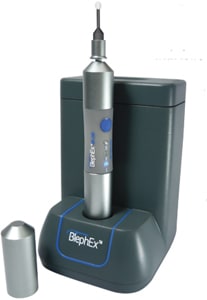SPOTLIGHT ON TECHNOLOGY & TECHNIQUE
BlephEx treatment aims to reduce blepharitis damage
By putting control in the doctor’s hand, this device can improve lid health and hygiene.
By Bill Kekevian, Senior Associate Editor
Keeping eyelids clean should be as routine as brushing your teeth, says James Rynerson, MD, who practices in Palm Springs, Fla. He sees the damage inflammatory blepharitis causes tear glands as a vicious cycle.
As people age they make fewer natural antibodies in the tear film, allowing for an overgrowth of bacteria. The bacteria produce endotoxins that accumulate in the biofilm and in debris along the lid margin, hence blepharitis. The endotoxins cause inflammation of the lid margin and tear glands. This chronic, low-grade inflammation causes tear glands to decrease production, resulting in fewer tears with fewer antibodies.
In his private practice, Dr. Rynerson has been frustrated in combating blepharitis. “In my opinion, untreated inflammatory blepharitis is the cause of the majority of dry eye,” he says. But when home lid scrub treatments proved ineffective, he set out to create a better solution. With that in mind, he cofounded the company RySurg to develop the BlephEx, a handheld device with which doctors or technicians can clean lid margins.

HOME SCRUB TROUBLES
“Previously, the only way we had to break the cycle of blepharitis was to send the patient home with lid scrubs and hope they could do it,” he says. The problem has been that patients find performing lid scrubs at home uncomfortable and inconvenient.
“Some patients are non-compliant,” he says. But even for compliant patients, problems arise. “Many just don’t have a full grasp of what they’re trying to accomplish,” he says. Home lid scrubs can do a fair job of keeping the lids clean, but a terrible job of getting the lids clean in the first place, he adds.
TAKING CONTROL
The BlephEx is designed to put the control of blepharitis in the physician’s hand, taking its inspiration from dental cleanings. A gentle, PVA sponge on the tip spins at 1,000 RPM along the edge of the eyelids. The device allows physicians, who know what to look for, to remove build-up in the clinic.
With a clean slate, Dr. Rynerson says, the cursory job patients perform with home lid-scrubs become more effective. The BlephEx procedure not only breaks the cycle of blepharitis, it also allows the body’s own healing mechanisms to restore the health of tear glands. “I believe by unroofing the meibomian glands, stimulating the lid margin and keeping it free of inflammation, we can eventually heal glands,” he says.
CHANGING PATIENT CARE
As eye care embraces dry eye management, Dr. Rynerson says the BlephEx can complete the dry-eye-focused practice. Using it “every four to six months not only improves patients symptoms, but in the long run, can reduce severe dry eye,” he says. BlephEx is “out of the realm of insurance companies,” he says. A private-pay procedure, it costs patients about $150-200 per treatment.
Although he likes to compare the procedure to a teeth cleaning he points out one key difference. “You can get fake teeth,” he says, “but you can’t get fake eyelids.” OM








